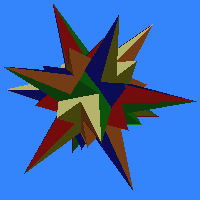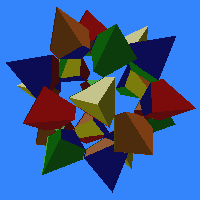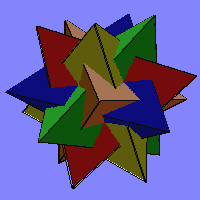Stellations of the Icosahedron
 A
few of these we have seen elsewhere: the great
icosahedron is one of the Kepler-Poinsot
polyhedra, and the first stellation in the official list is just the
icosahedron itself. Some other stellations are familiar compounds:
the compound of five
octahedra, the compound
of five tetrahedra, and the compound
of ten tetrahedra. However, most of the 59 are simply beautiful new
polyhedra, well worth a look. The one illustrated at left is relatively
easy to make out of paper because it requires
pieces of only a single shape.
A
few of these we have seen elsewhere: the great
icosahedron is one of the Kepler-Poinsot
polyhedra, and the first stellation in the official list is just the
icosahedron itself. Some other stellations are familiar compounds:
the compound of five
octahedra, the compound
of five tetrahedra, and the compound
of ten tetrahedra. However, most of the 59 are simply beautiful new
polyhedra, well worth a look. The one illustrated at left is relatively
easy to make out of paper because it requires
pieces of only a single shape.
I have rendered each of these models with two different coloring schemes: monochromatic and five colors. For the five-colored versions, each of the 20 icosahedral planes is assigned a color according to this five-coloring of the icosahedron, which in turn comes from the most famous of its stellations, the compound of five tetrahedra. (Travel inside it to see the five-colored icosahedron at its core. Note that two triangles of the same color never touch. There are two ways to do this; the other way is the mirror image of this one.) So in each of the 59 stellations, for each color there are four faces, arranged according to the planes of one of the five tetrahedra in the compound of five tetrahedra. Knowing this should help to make clear the common planes of different facets.
 Here
are a few of my favorites:
Here
are a few of my favorites:
- #4 (monochromatic)
- #5 (monochromatic)
- #15 (monochromatic)
- #24 (five colors)
- #34 (five colors)
- #38 (five colors)
- #45 (monochromatic)
And here is the complete list of 59 stellations of the icosahedron.
 Exercise:
Note that both the shape
of the compound of five tetrahedra and the color
pattern of the five-colored icosahedron are chiral. If we reflect a
five-colored compound
of five tetrahedra in a mirror, we are actually reflecting two things,
the shape and the coloring. What results if we reflect just one of these
two aspects? In other words, imagine assigning colors to the planes of
the compound's shape according to the colors of the reflected colored icosahedron.
Exercise:
Note that both the shape
of the compound of five tetrahedra and the color
pattern of the five-colored icosahedron are chiral. If we reflect a
five-colored compound
of five tetrahedra in a mirror, we are actually reflecting two things,
the shape and the coloring. What results if we reflect just one of these
two aspects? In other words, imagine assigning colors to the planes of
the compound's shape according to the colors of the reflected colored icosahedron.
Answer: If you can't imagine the result, at least determine its symmetry group before looking at the answer.
If you are willing to relax the condition that the stellations have icosahedral symmetry, there are many stellations of the icosahedron with tetrahedral symmetry.